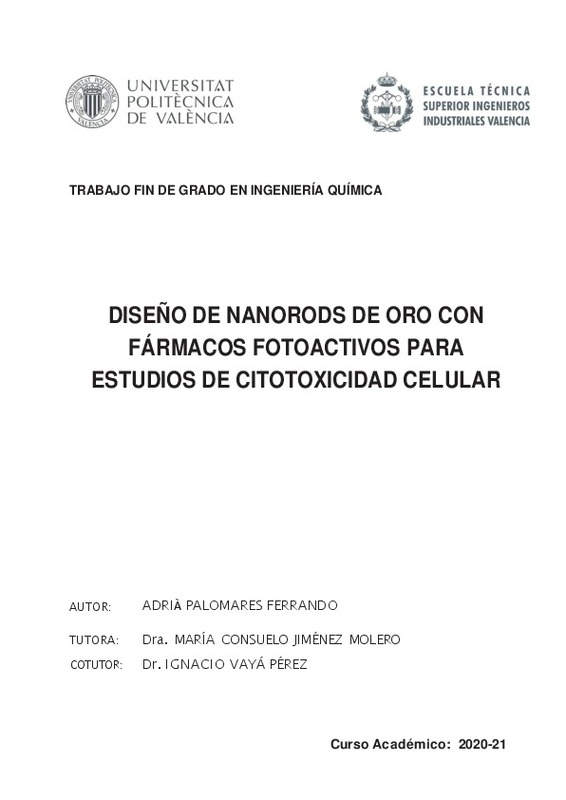JavaScript is disabled for your browser. Some features of this site may not work without it.
Buscar en RiuNet
Listar
Mi cuenta
Estadísticas
Ayuda RiuNet
Admin. UPV
Diseño de nanorods de oro con fármacos fotoactivos para estudios de citotoxicidad celular
Mostrar el registro sencillo del ítem
Ficheros en el ítem
| dc.contributor.advisor | Jiménez Molero, María Consuelo
|
es_ES |
| dc.contributor.advisor | Vayá Pérez, Ignacio
|
es_ES |
| dc.contributor.author | Palomares Ferrando, Adrià
|
es_ES |
| dc.date.accessioned | 2021-10-06T14:41:45Z | |
| dc.date.available | 2021-10-06T14:41:45Z | |
| dc.date.created | 2021-09-10 | |
| dc.date.issued | 2021-10-06 | es_ES |
| dc.identifier.uri | http://hdl.handle.net/10251/174035 | |
| dc.description.abstract | [ES] Este proyecto se ha centrado en el diseño y estudio de las propiedades de nanorods de oro para su posible aplicación en terapia fototérmica (PTT), para el tratamiento de ciertos tipos de cánceres. La terapia fototérmica se basa en producir un aumento localizado de la temperatura en la zona tumoral con la consiguiente muerte de las células cancerosas. Para ello, se emplean los nanorods de oro (AuNRs), que tras ser irradiados con luz cercana al infrarrojo provocan un aumento de la temperatura debido a sus propiedades estructurales y ópticas características, sin generar daño significativo a los tejidos no cancerosos, ya que no absorben radiación a esa longitud de onda. Por este motivo, se han sintetizado diferentes AuNRs con el fin de estudiar sus propiedades fototérmicas en función de su tamaño y de su funcionalización con moléculas biocompatibles, tales como PEG y proteínas (HSA). Para analizar las propiedades fototérmicas de las diferentes muestras de AuNRs con el fin de investigar su posible uso en PTT, se realizó un experimento donde se irradiaron las distintas muestras con luz de distinta energía. Se observó que se generan diferentes incrementos de temperatura dependiendo del tamaño de los AuNRs. Con estas muestras se realizaron ensayos de viabilidad celular utilizando células cancerosas de mama humana (SKBr-3). En general, se observó que la irradiación de los AuNRs a 808 nm induce un aumento de la citotoxicidad, debido al aumento localizado de la temperatura en las células. También se observó que la funcionalización de AuNRs con HSA y PEG mejoran la biocompatibilidad del nanomaterial, ya que provoca menor muerte celular sin ser irradiados; sin embargo, tras irradiar a 808 nm, la muerte celular aumenta considerablemente, el cual es uno de los principales objetivos buscados en este proyecto. | es_ES |
| dc.description.abstract | [EN] This project has focused on the design and study of the properties of gold nanorods for their possible application in photothermal therapy (PTT), i. e. for the treatment of certain types of cancers. Photothermal therapy is based on producing a localized enhancement of the temperature in the tumor area, with the consequent death of cancer cells. For this purpose, gold nanorods (AuNRs) have been used, which after being irradiated with near infrared-light, are able to induce an increase in temperature due to their characteristic structural and optical properties, without generating significant damage to non-cancerous tissues, since they do not absorb radiation at this wavelength. For this reason, different AuNRs have been synthesized and functionalized with biocompatible molecules, such as PEG and proteins (HSA), in order to study their photothermic properties as a function of their size. To analyze the photothermic properties of the different AuNRs in order to investigate their possible use in PTT, an experiment was carried out where all samples were irradiated with light of different energies. It was observed that the temperature rises differently depending on the size of AuNRs. Finally, cell viability assays were performed using human breast cancer cells (SKBr-3). In general, it was observed that the irradiation of AuNRs at 808 nm induces an increase of cytotoxicity, due to the localized enhancement of the temperature within the cells. It was also observed that the functionalization of AuNRs with HSA and PEG improve the biocompatibility of the nanomaterials, since it induces less cell death without being irradiated; however, after irradiation at 808 nm, cell death increases considerably, which is one of the main objectives of this project. | es_ES |
| dc.format.extent | 97 | es_ES |
| dc.language | Español | es_ES |
| dc.publisher | Universitat Politècnica de València | es_ES |
| dc.rights | Reserva de todos los derechos | es_ES |
| dc.subject | Células SKBr-3 | es_ES |
| dc.subject | Fármacos | es_ES |
| dc.subject | Fluorescencia | es_ES |
| dc.subject | Fotólisis de destello láser | es_ES |
| dc.subject | Nanorods de oro | es_ES |
| dc.subject | Proteínas | es_ES |
| dc.subject | SKBr-3 cells | es_ES |
| dc.subject | Drugs | es_ES |
| dc.subject | Fluorescence | es_ES |
| dc.subject | Laser flash photolysis | es_ES |
| dc.subject | Gold nanorods | es_ES |
| dc.subject | Proteins | es_ES |
| dc.subject.classification | QUIMICA ORGANICA | es_ES |
| dc.subject.other | Grado en Ingeniería Química-Grau en Enginyeria Química | es_ES |
| dc.title | Diseño de nanorods de oro con fármacos fotoactivos para estudios de citotoxicidad celular | es_ES |
| dc.type | Proyecto/Trabajo fin de carrera/grado | es_ES |
| dc.rights.accessRights | Abierto | es_ES |
| dc.contributor.affiliation | Universitat Politècnica de València. Departamento de Química - Departament de Química | es_ES |
| dc.contributor.affiliation | Universitat Politècnica de València. Escuela Técnica Superior de Ingenieros Industriales - Escola Tècnica Superior d'Enginyers Industrials | es_ES |
| dc.description.bibliographicCitation | Palomares Ferrando, A. (2021). Diseño de nanorods de oro con fármacos fotoactivos para estudios de citotoxicidad celular. Universitat Politècnica de València. http://hdl.handle.net/10251/174035 | es_ES |
| dc.description.accrualMethod | TFGM | es_ES |
| dc.relation.pasarela | TFGM\141621 | es_ES |
Este ítem aparece en la(s) siguiente(s) colección(ones)
-
ETSII - Trabajos académicos [10404]
Escuela Técnica Superior de Ingenieros Industriales






